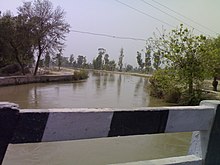Ganga Canal (Rajasthan)
| Ganges Canal (Bikaner canal) |
|---|
The Ganges or Ganga Canal of Rajasthan is an irrigation system of canals laid down by Maharaja Ganga Singh of Bikaner in his Princely state in the early nineteenth century in today's district of Sri Ganganagar.it passes through Punjab's Firozpur, Faridkot districtand Muktsar Dist. it passes throuh faridkot's Jhok Sarkari village
History

The Bikaner state was affected by the worst famine in 1899–1900. In order to get rid of this problem permanently, in 1903 Maharaja Sri Ganga Singh obtained the services of A. W. E. Standley, Chief Engineer, who demonstrated the feasibility of the western area of the Bikaner State being brought under irrigation from the Satluj Waters. The plan of the Satluj Valley Project was drawn by then Chief Engineer of Punjab Mr. R. G. Kennedy according to which the vast area of erstwhile Bikaner state could be brought under irrigation. Because of objections by the erstwhile State of Bahawalpur, the project got delayed and finally with intervention of then Viceroy of India, Lord Curzon, in 1906, a Tripartite Conference was held and an agreement was reached and signed on 4 September 1920. The foundation stone of the Canal Head Works at Ferozepur was laid on 5 December 1925 and the work completed in 1927 by constructing 89 miles of lined canal. The opening ceremony was performed on 26 October 1927 by Lord Irwin, the then Viceroy of India. The plan for Sri Ganganagar was drawn at this time. And irrigated parts of Bikaner state came under Sri Ganganagar district and now parted Hanumangargh District.
